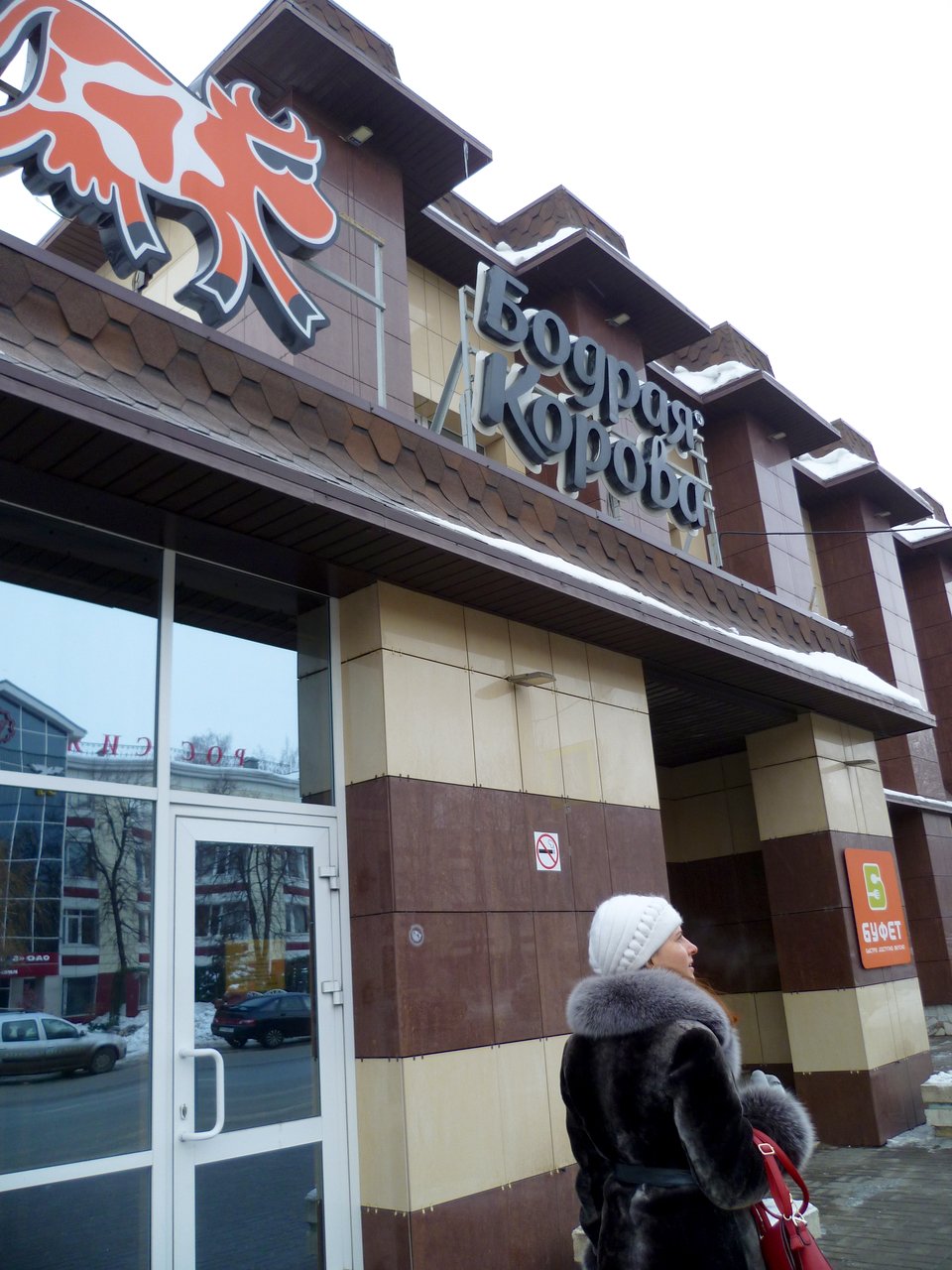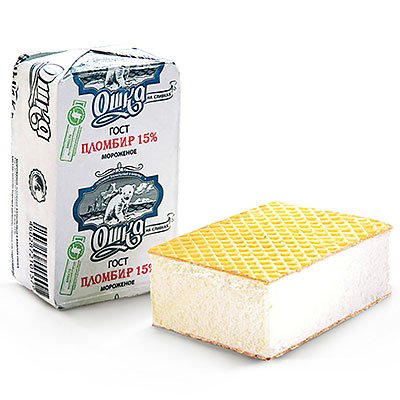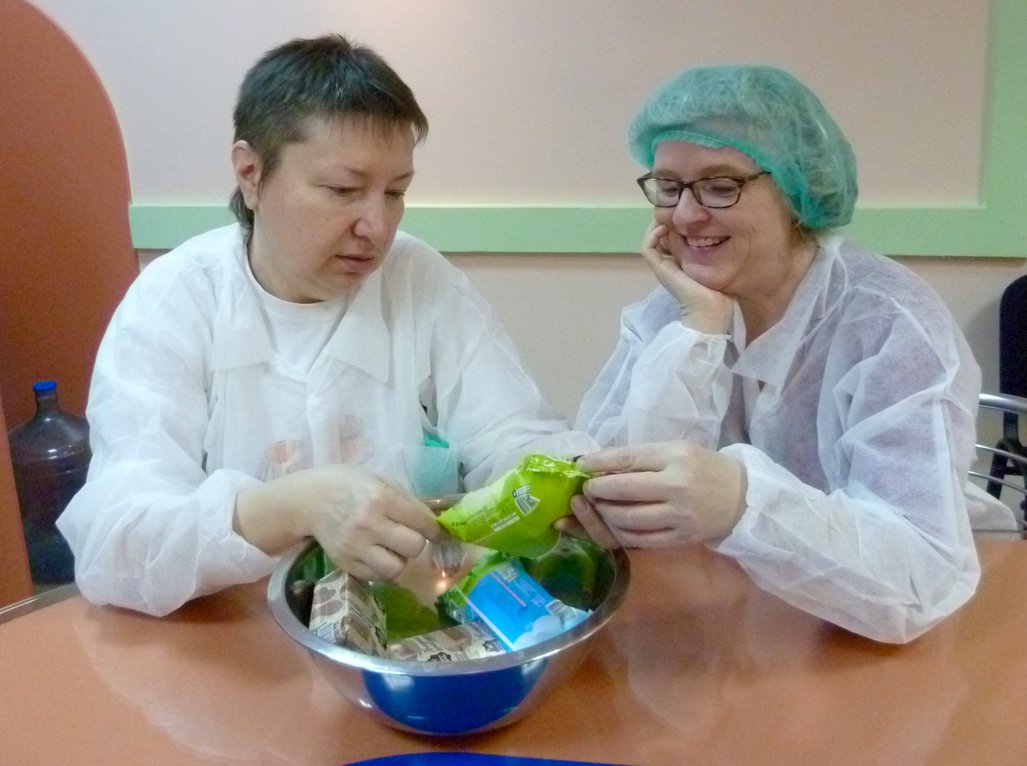The cheerful cow
One of the most unexpected things about my time here in Belgorod is how I have become obsessed with milk products. Belgorod has the most delicious milk, yogurt, kefir, etc. that I have ever tasted in my life. You go to the store and you buy yogurt that was made that very day. My usual grocery basket looks basically like this:
Yogurt, kefir, ryazhenka, ice cream
In fact, if I'm honest with myself, I really only eat one regular meal a day. The rest is all milk of some variety. What am I going to do when I return to the U.S.?
More to the point, what is the funnest milk product of all? Well, ice cream, of course. And Belgorod has a really great ice cream factory called Бодрая Корова, or "Cheerful Cow." My friend Olga was enterprising and finagled us a tour there in January.Olga and I took the bus out into the industrial section of the city known as Kreyda (named in the late 19th century for the German word kreide, which means "chalk." Apparently this is where Belgorod's chalk was loaded onto trains headed west for sale). Today it's home to many factories, but also new housing developments. So while some areas definitely have that factory feel, others are quite homey. Anyway, Olga and I got out at the stop for the Cheerful Cow and I immediately took a picture.
We walked inside and no fewer than three security guards asked us questions about why were we there. One was particularly stern and asked us why we had taken a photo. Then he said we had to pay for it. Olga calmly maneuvered all of this, just saying that we were there for an excursion and to please call the tours department. He was so stern and so deadpan that it took me ages to understand that he was joking. I finally caught on when he said to me, again, very sternly, "Why is your purse so small? What can you carry in there?" I burst out laughing and he threatened to charge me money for laughing on ice cream factory property.
Tatiana, our guide, first took us into a large room with a plasma-screen TV and sat us down in front of a short film about the history of the factory. Like all things in Western Russia, the Second World War was a major influence. As I've mentioned elsewhere, Belgorod was basically completely destroyed during the war, with only about 150 Belgoroders surviving. The reconstruction was arduous and for many years there were not enough resources for every family to have a refrigerator. So in 1959 the city built a giant refrigerator to serve the entire urban area holding several thousand tons of meat and fish.
In 1973, the giant refrigerator was expanded into an ice cream factory and the Communist Party set the factory's output goal in order to fulfill the economic plan: each shift should produce six thousand tons of ice cream! In the 80s, a dry ice plant was added. After the fall of the Soviet Union, the company started buying foreign technology; in 1996 they bought their first "extrusion" machine (this is the machine that squirts ice cream into shapes, like the shape for putting on a stick). The plant was privatized in 1998 and in 2000 became the "Cheerful Cow." Now the plant makes dozens of varieties of ice cream treats and even sells them for export to the Czech Republic and Israel, among others.
The original, giant refrigerator is still in use:
Then Tatiana took us around the small collection of exhibits. On the top shelf you can see models of typical Soviet ice cream in the little cup. This style is still extremely popular. Below that you can see the range of added fruits and nuts used in the factory today.
Next we got to tour the factory! First we had to put on special white robes, booties, and hair caps.
First we were shown to the area where they mix the batter for the cones, pour them into molds, and bake them. It all happens so fast. One machine does it all-- it squirts in the batter, then it tamps it down into the mold, then it sends it through the oven, then it gently slides the cone onto a ramp where workers inspect them for quality. We weren't allowed to take photos, but the machine looks kind of like this video.
The area of the factory where they make the ice cream mix is restricted for health reasons, so we could not see it, but Tatiana told us about the huge containers of milk, butter, condensed milk, etc. that are combined to make the base for the ice cream. Milk arrives at the factory only two hours after milking!
Next we saw where they pour cold, but not frozen, ice cream into the cones. Afterward, they are sent to be flash frozen for, like, a minute or so. Tatiana assured us that the not-yet-frozen ice cream is the most delicious there is, but that you cannot sell it because it is not stable for transport. She promised us a taste later.
Most of their machines are Danish or Italian, but a few are Soviet workhorses that are still in continuous use. She explained that this is because only the Soviet Union made ice cream briquettes, kind of like an ice cream sandwich with waffles instead. They look like this:
Amazingly, the machines are still strong and when they break down, they simply fix them again. Many in the ice cream industry predicted that the briquette and the Soviet cup would go away when Russians got a taste for Western ice cream. But not at all. In fact, they are still the most popular (by sales of units) ice creams to this day.
The tasting room was, of course, the highlight. Olga and I amused ourselves with the stuffed cows. They gave us a ton of ice cream, most of which we simply could not eat.
As promised, she let us try the not-quite-ice cream. It was tasty, but I still prefer the finished kind.
One thing that was unexpectedly interesting to me was the differences in the ice cream industry in Russia and in the US. In the US we buy big tubs of ice cream and scoop it out for ourselves at home. This is just not done in Russia. I explained how the typical image of a heartbroken person in the US is someone in pajamas on the couch eating ice cream out of the carton. She rolled her eyes and said that in Russia the typical image of heartbreak probably involves vodka. But, anyway, most ice cream here is purchased in individual, single-serving units. Every year Cheerful Cow puts out about a dozen new flavors of ice cream and she says success depends on trends, just like in fashion. When people are feeling more adventurous, they want exotic flavors like mango. When they are feeling more traditional, they prefer just plain tastes, vanilla and chocolate. Last year they had a not-particularly-popular coconut product. Tatiana herself prefers their fruit flavors, but they are not as popular with the general public. They are currently pushing a new pistachio flavor, which she is showing me here. I notice it in the stores, too. In fact, I sometimes get frustrated that my favorite vanilla is gone and the only thing left is pistachio.
Their most popular flavor has always been the 1948 ice cream recipe sold in the paper package: the only ingredients are milk, condensed milk, butter, sugar and flour (which is used instead of artificial stabilizers).
Russian ice cream is so filling I often eat it instead of a meal. Hm...it's lunch time about now. Think I'll go get myself some.
And look! Here's Tatiana on TV showing around some guests from Kursk! You can see almost the whole process here and how enthusiastic she is about her job.











